lies like truth: November 2010 Archives
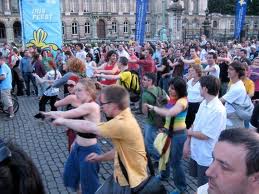 I've received several YouTube links from friends in recent weeks with footage of various "flash mob" performance happenings around the world, from outbreaks of Italian opera by fruit and vegetable vendors in Spanish markets to teenagers performing hip-hop dance routines in Australian train stations.
I've received several YouTube links from friends in recent weeks with footage of various "flash mob" performance happenings around the world, from outbreaks of Italian opera by fruit and vegetable vendors in Spanish markets to teenagers performing hip-hop dance routines in Australian train stations.Seems like flash mobs are all the rage these days. They're a wonderful idea because they create a sense of immediacy, bring art to a wide audience and help to blow the dust of artistic genres that many people tend to associate with musty theatres and high ticket prices.
On the flip side, flash mobs tend to trivialize art and it's very often the case that the surprise/spectacle element far outdoes the artistic quality of the work on display.
On balance though, I'm all for these colorful interventions into everyday life. If nothing else, they serve as a reminder that there is creativity and a sense of humor in every corner.
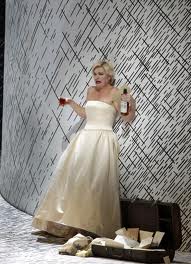 If an artistic event has been and gone, is it still worth writing about?
If an artistic event has been and gone, is it still worth writing about?Timeliness is of course next to godliness when it comes to arts journalism. But sometimes I think that the media places too much of an emphasis on coverage as a means of driving audiences to experience a particular artistic event. Sure, it makes sense both from the producing organization's perspective and media organization's perspective to publish content that can drive sales. Yet there should be more to arts journalism than touting a current arts event.
I bring this up because I planned to write about the San Francisco Opera's production of Janacek's little-performed The Makropoulos Case today. But I just realized that the final performance happened yesterday. So, is there any real point in saying what I think of the production if no one can see it?
ArtsJournal, I notice, tends in general to stay away from giving prominence on its homepage to blog entries that offer commentary about individual arts events, probably because the editor figures that 99% of the global readership won't be able to experience the event under discussion.
I still think there's a place for commentary after the fact though, and it's great at least that the "gate-keeper-less" blogging format allows for such entries, even if they don't claim as high a status as entries that deal with more topical / trend-based themes might. For one thing, commentary on any work of art composed even years after the event is over, is one way of capturing its essence and fixing it in people's memories. For another, it helps to build a useful and often fascinating record of a body of work.
On the other hand, I don't think I'll write a full-on review of The Makropoulos Case this time, even though I loved it and wish the run could have been longer so I could see the production again and encourage others to get to it. I guess the main reason for this reluctance is simply that so much has been said about the opera in recent weeks. On this occasion I don't think I have much new to add to the mix. Hence the rather "meta" nature of this blog post.
Oh well. Having started out by saying that there is a case for writing a response to a work very late, I've now gone and demonstrated a set of circumstances in which doing so shall remain an aspiration.
 A few days ago I exchanged email with a friend who works in the arts media landscape. I asked him how he was doing. "Can't complain. My life is a process of creative problem-solving," he responded.
A few days ago I exchanged email with a friend who works in the arts media landscape. I asked him how he was doing. "Can't complain. My life is a process of creative problem-solving," he responded.I realized that what he said pretty much describes my life. (Then again, when it comes down to it, the sentiment could be applied to just about anyone in any field trying to make his or her way in the world.)
It's been a couple of days of intense creative problem solving for me, anyway. It all began on Monday afternoon, when I heard from the guest who was supposed to come into the radio station with me this week to record a VoiceBox episode about hula chanting: He had come down with the flu and wouldn't be able to do the show the following day as planned. Within the space of 24 hours, I'd managed to organize, write, produce and host an entirely new program.
And the creative problem-solving didn't stop there. Because the newly-dreamed-up VoiceBox theme -- about an obscure a cappella choral mass by Milton Babbitt -- required input from two in-studio guests and a third calling into the radio station on the phone (something I'd never attempted before), the studio engineer at KALW (whom I'd never collaborated before) worked miracles on the spot to make it all happen.
Looking back at the last 40 hours or so, I'm amazed that it all came together.
Thank goodness there's a public holiday coming up tomorrow. It's much needed. Which brings me to my extended absence greeting: I'll be back on the blogosphere on Monday. The most creative problem-solving I plan to between now and then is figuring out how to make fake cream cheese frosting for my homemade carrot cake given that the people I will be celebrating with are hemp-chewing vegans. Happy holidays.
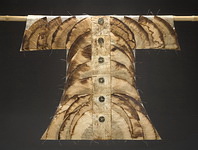 Exhibitions based on handicrafts have been making a big comeback in the Bay Area in recent years, what with the city's two museums dedicated to crafts helping to spotlight artists who work in handicraft media and organizations like YBCA also doing their part to put on exhibitions focusing on crafts.
Exhibitions based on handicrafts have been making a big comeback in the Bay Area in recent years, what with the city's two museums dedicated to crafts helping to spotlight artists who work in handicraft media and organizations like YBCA also doing their part to put on exhibitions focusing on crafts.The visual art show of works by the fiber/DIMENSIONS artists' collective currently going on at The Presidio Officers' Club Exhibition Hall through December 19 -- intersections 5 -- furthers the campaign to divest basket-weaving, knitting, crochet, applique and other time-honored techniques from the musty clutches of the village hall blue rinse brigade.
The diverse exhibition curated by Richard Elliott includes everything from kimonos made of stained coffee filters (a fascinating combination of Eastern and Western cultural traditions) by Lucia Matzger (pictured), to delicate lace forms by Jeanette Carr. The variety and color on display as well as the ways in which the artists nudge us into thinking about the materials and unusual structures they take makes us the world of things in a new way.
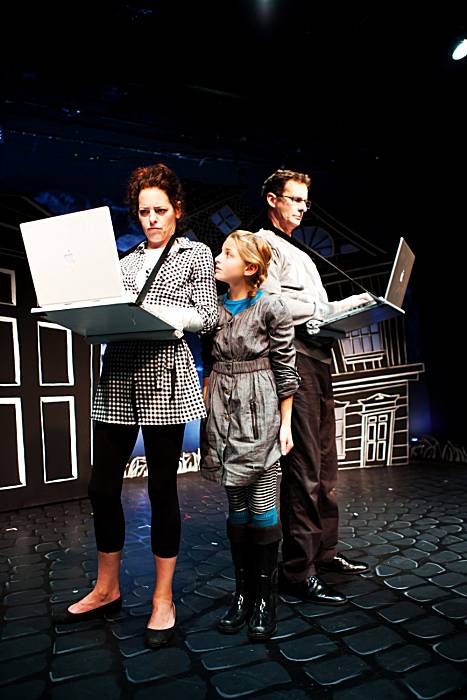
SF Playhouse is a company in San Francisco that is remarkable for the slickness of its output. The organization's prolific productions usually belie what most people normally think of as "black box theatre": The actors are among the best in the Bay Area, the sets and lights are always gorgeous and the programming is often engaging and sometimes risky.
The company's latest production, Coraline, is different though -- though sweet and festive in its own way, it feels like a school play.
It's hard to pin down why this is the case exactly and having thought about it, whether the aesthetic (if it is indeed intended) is good or bad.
The school playishness of Coraline doesn't have anything to do with the fact that the protagonist, a girl who goes through a mysterious door in her house and enters a surreal parallel universe complete with scary parents and a talking cat, is played by a very young actress. Maya Donato brings a great deal of sensitivity and humor to the character.
David Greenspan's no-nonsense adaptation of Neil Gaiman's children's novel and Stephin Merritt's delicate score for piano, prepared piano and toy piano may have something to do with the issue, however. Having composed most of this blog post, I just read Robert Hurwitt's review in The Chronicle and I think he's right when he says: "Greenspan's make-believe approach undercuts the tale's suspense and tends to make good actors look like amateurs. Merritt's inventive but cerebral score - for toy and prepared pianos - works against any emotional connection with Coraline's plight in the alternative world beyond that mysterious door."
I wonder whether the amateurish sensation also has something to do with the fact that SF Playhouse's space is really too small for this larger-than-life musical? The intimacy of the space is normally one of the company's greatest assets. But in this case, there's not enough distance from the pop-up book buildings that make up the set. They look especially flimsy and tinny. There's something also jejeune about some of the staging ideas, such as the scene in which Stacy Ross as the Jekyll and Hyde-like mother figure falls down a well. The cast members pick up a large disc sitting on top of the well and pull it over the actress' body so that it appears as if she's falling. Except that it doesn't. All I could think of as I watched Stacy Ross wave her arms about in the middle of the disc is my childhood hooplah games.
The company's latest production, Coraline, is different though -- though sweet and festive in its own way, it feels like a school play.
It's hard to pin down why this is the case exactly and having thought about it, whether the aesthetic (if it is indeed intended) is good or bad.
The school playishness of Coraline doesn't have anything to do with the fact that the protagonist, a girl who goes through a mysterious door in her house and enters a surreal parallel universe complete with scary parents and a talking cat, is played by a very young actress. Maya Donato brings a great deal of sensitivity and humor to the character.
David Greenspan's no-nonsense adaptation of Neil Gaiman's children's novel and Stephin Merritt's delicate score for piano, prepared piano and toy piano may have something to do with the issue, however. Having composed most of this blog post, I just read Robert Hurwitt's review in The Chronicle and I think he's right when he says: "Greenspan's make-believe approach undercuts the tale's suspense and tends to make good actors look like amateurs. Merritt's inventive but cerebral score - for toy and prepared pianos - works against any emotional connection with Coraline's plight in the alternative world beyond that mysterious door."
I wonder whether the amateurish sensation also has something to do with the fact that SF Playhouse's space is really too small for this larger-than-life musical? The intimacy of the space is normally one of the company's greatest assets. But in this case, there's not enough distance from the pop-up book buildings that make up the set. They look especially flimsy and tinny. There's something also jejeune about some of the staging ideas, such as the scene in which Stacy Ross as the Jekyll and Hyde-like mother figure falls down a well. The cast members pick up a large disc sitting on top of the well and pull it over the actress' body so that it appears as if she's falling. Except that it doesn't. All I could think of as I watched Stacy Ross wave her arms about in the middle of the disc is my childhood hooplah games.
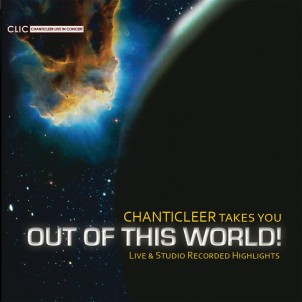 Chanticleer's attempt to reach broader audiences through online music downloads and adventurous forays into new repertoire are laudable.
Chanticleer's attempt to reach broader audiences through online music downloads and adventurous forays into new repertoire are laudable. But the release of its first ever music video, featuring the group singing Vincent Peterson's arrangement of indie-pop composer Erika Lloyd's "Cells Planets" is the first time that I have seen Chanticleer, a group which epitomizes choral professionalism, put out anything amateurish.
There's nothing wrong with the music per se. Soprano Casey Breves does an angelic job on the song's spiraling, heartfelt solo line. And the rest of the ensemble backs him up with understated warmth.
The trouble is that the filming looks thrown together in the mould of an iTunes video. I know this was a deliberate move on the ensemble's part. Perhaps they think this makes them seem more approachable. But it's not cute. It just makes the singers look bad.
Plus the concept -- which involves Chanticleer members traveling around the country while trying to stay in touch with loved ones back home -- is pretty trite and unimaginative.
Come on, boys. Apply the same level of perfection you bring to singing to everything you do. Go ahead and hire a real movie director next time you want to make a film. It'll be worth it, I assure you.
 Shattered but happy after pulling off first ever full-scale fundraising event for VoiceBox, my weekly public radio project on KALW 91.7 FM all about singing, last night. Leah Garchik, the fabulous San Francisco Chronicle columnist who co-hosted the soiree with me, touched me deeply by penning some sweet and funny verses for the occasion. Leah read out her poem infront of the assembled crowd at Salle Pianos in Hayes Valley, San Francisco. It went like this:
Shattered but happy after pulling off first ever full-scale fundraising event for VoiceBox, my weekly public radio project on KALW 91.7 FM all about singing, last night. Leah Garchik, the fabulous San Francisco Chronicle columnist who co-hosted the soiree with me, touched me deeply by penning some sweet and funny verses for the occasion. Leah read out her poem infront of the assembled crowd at Salle Pianos in Hayes Valley, San Francisco. It went like this:What new on the Rialto
Inquires the nosy contralto
The venue is local
For melodies vocal
For tenor or even an alto
A trill or a glide or a croon
There's never a way you can ruin
A ditty or chant
Or even a rant
As long as it's set to a tune
So if you're gay or a breeder
The songs will say it in meter
The angriest cur
Is likely to purr
In yodels or even in lieder
The process can seem quite remote
But experts are swift to take note
The connoisseur's pleasure
Finds something to treasure
When music comes out of the throat
In elevators, even in showers
Alone your ability towers
The phrases come pouring
Crescendoes are soaring
My God, you have wonderful powers
But aiming the soul to unfetter
In chorus, it's even much better
And just like the birds
With tweets or with words
Each song-mate's a tuneful abettor
It's true that in music and life
When pitching-in chances are rife
The lesson is oft
A solo is soft
But harmony overcomes strife
Each broadcast deserves an ovation
And happy support from the station
But even while eager
Resources are meager
So thanks for your every donation
Because she is nuts about singing
This gathering Chloe is flinging
VoiceBox deserves praise
And bucks she can raise
The registers should be ka-chinging.
Thank you Leah! And thanks to everyone who came out and supported last night's event.
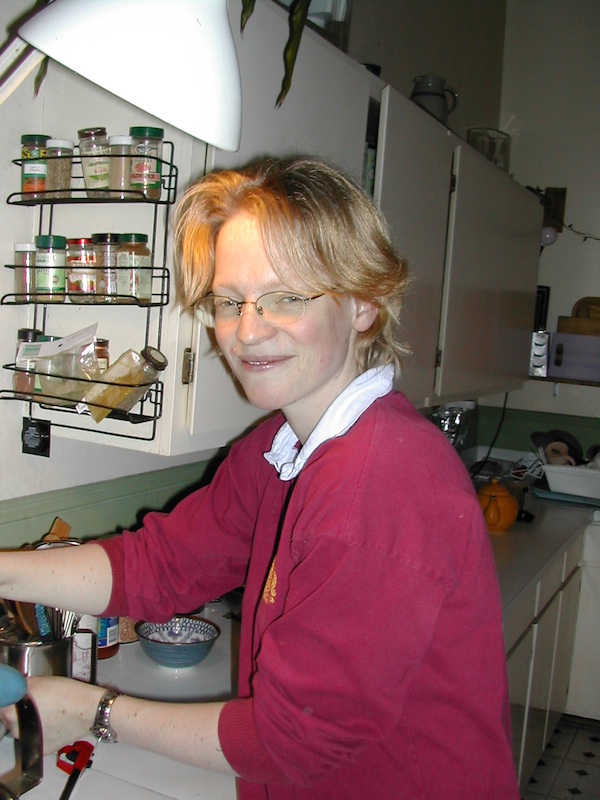 When ArtsJournal publishes memorial pieces or formal obituaries, they're usually of household names or at least leading figures in the world of the arts. This morning, however, I'd like to pay homage to an amazing choreographer, beautiful dancer, deep thinker and dear friend, Niki Pollard, who passed away on Monday following a nearly five-year battle against cancer. She was 37 years old.
When ArtsJournal publishes memorial pieces or formal obituaries, they're usually of household names or at least leading figures in the world of the arts. This morning, however, I'd like to pay homage to an amazing choreographer, beautiful dancer, deep thinker and dear friend, Niki Pollard, who passed away on Monday following a nearly five-year battle against cancer. She was 37 years old.Niki and I attended university together in the mid-1990s in England. We both read English literature and bonded over dance. Following graduation, I spent much of my early 20s rampaging around London with Niki. It was Niki who took me to see a lot of the great UK dance companies for the first time such as the London Contemporary Dance Theatre and Ballet Rambert. I also enjoyed doing contact improvisation classes with Niki in the west end and being a body whenever her choreographic inspiration took hold -- she enjoyed making up dance sequences on the living room carpets of friends' homes around town.
Inn addition to being deeply connected to her body and soul, Niki also had a mind to be reckoned with: She earned a double first class degree in English literature from Corpus Christi College Cambridge and went on to win an extremely competitive humanities board grant to undertake and earn Masters and PhD degrees in dance. Niki did her masters at the Laban School and her doctorate at Middlesex Uni. She finished her PhD, raised two lovely children -- Amy and Robin -- and lived in the west country with her kids and husband Chris.
Chris sent through an email with news of her passing. The sad message arrived in my inbox an hour ago. Despite my numb feelings, his words in part made me smile. "Happily, Niki was doing the things she loved most, right to the end," he wrote. "Even dancing on the moor with dance friends from Coventry last Thursday."
I will always think of Niki dancing.
 The festive season is fast approaching and once again the Bay Area is abundant with opportunities for listening to and singing along with The Messiah. Here is a shortlist of some of the regional outings of Handel's holiday favorite in the coming weeks:
The festive season is fast approaching and once again the Bay Area is abundant with opportunities for listening to and singing along with The Messiah. Here is a shortlist of some of the regional outings of Handel's holiday favorite in the coming weeks:Philharmonia Baroque Orchestra and Chorale (first time in a decade! -- choir pictured above)
Nicholas McGegan, Music Director
Philharmonia Chorale, Bruce Lamott, Director
Mary Wilson, soprano
Daniel Taylor, countertenor
John McVeigh, tenor
Tyler Duncan, bass
Friday 3 December, at 7:30pm Herbst Theatre, San Francisco
Saturday 4 December at 7:30pm First Congregational Church, Berkeley
Sunday 5 December at 7:00pm First Congregational Church, Berkeley
Tuesday 7 December at 7:30pm Menlo-Atherton Performing Arts Center, Atherton
Sing-Along Messiah
Sunday, Dec 5 3:00p
Lakeside Presbyterian Church, SF
The San Francisco Sinfonietta and Chorus Present Sing it Yourself Messiah
Mission Dolores Basilica
December 6, 2010 - 7:30pm
San Francisco Symphony Handel's Messiah
Ragnar Bohlin, conductor
Kiera Duffy soprano
Tove Dahlberg mezzo-soprano
Benjamin Butterfield tenor
Robert Gleadow bass
San Francisco Symphony Chorus and San Francisco Symphony
December 15 (8pm Flint Center Cupertino), Dec 16, (7.30pm Davies Symphony Hall, SF), Dec 18, (7.30pm Davies Symphony Hall, SF), and Dec 19 (2.00pm Davies Symphony Hall, SF).
Monterey Symphony Messiah.
Carmel Mission, 3080 Rio Road, Carmel, December 10, 8:00 PM.
San Francisco Academy Orchestra Sing Along Messiah.
Alden Gilchrist, Conductor.
December 18 (10 am) and 19 (5pm), Calvary Presbyterian Church, 2515 Fillmore at Jackson, San Francisco.
Nicholas McGegan, Music Director
Philharmonia Chorale, Bruce Lamott, Director
Mary Wilson, soprano
Daniel Taylor, countertenor
John McVeigh, tenor
Tyler Duncan, bass
Friday 3 December, at 7:30pm Herbst Theatre, San Francisco
Saturday 4 December at 7:30pm First Congregational Church, Berkeley
Sunday 5 December at 7:00pm First Congregational Church, Berkeley
Tuesday 7 December at 7:30pm Menlo-Atherton Performing Arts Center, Atherton
Sing-Along Messiah
Sunday, Dec 5 3:00p
Lakeside Presbyterian Church, SF
The San Francisco Sinfonietta and Chorus Present Sing it Yourself Messiah
Mission Dolores Basilica
December 6, 2010 - 7:30pm
San Francisco Symphony Handel's Messiah
Ragnar Bohlin, conductor
Kiera Duffy soprano
Tove Dahlberg mezzo-soprano
Benjamin Butterfield tenor
Robert Gleadow bass
San Francisco Symphony Chorus and San Francisco Symphony
December 15 (8pm Flint Center Cupertino), Dec 16, (7.30pm Davies Symphony Hall, SF), Dec 18, (7.30pm Davies Symphony Hall, SF), and Dec 19 (2.00pm Davies Symphony Hall, SF).
Monterey Symphony Messiah.
Carmel Mission, 3080 Rio Road, Carmel, December 10, 8:00 PM.
San Francisco Academy Orchestra Sing Along Messiah.
Alden Gilchrist, Conductor.
December 18 (10 am) and 19 (5pm), Calvary Presbyterian Church, 2515 Fillmore at Jackson, San Francisco.
 There seem to be two schools of thought on the question of whether performers who are sick should attend rehearsals or stay away.
There seem to be two schools of thought on the question of whether performers who are sick should attend rehearsals or stay away.One school says: "Keep the hell away from the rehearsal room. You'll only make yourself feel worse and possibly infect everyone else around you!"
The other school says: "Come and sit away from everyone else. Even if you can't actively participate all of the time, at least you won't fall behind with the rehearsal process. And as long as you're not at death's door, you might even feel better for getting out and about a bit."
Depending on the extent of a performer's ill-health, the first option makes the most sense to me. Though there is a case to be made for the latter.
I've been down with sinusitis all week, which is why I'm thinking about this. Yesterday evening, after a weekend of lying in bed, I decided to attend a chorus rehearsal despite not feeling my best. My rationale: 1) I was over the worst of it; and 2) We have two concerts coming up this week, so missing this crucial final rehearsal would not have been ideal.
As it happened, half of the alto section of the International Orange Chorale was sitting to one side of the room at last night's rehearsal with one kind of health issue or another: There was me with my sinusitis, Alana nursing a bad cold, and Lea coping with the stomach flu. We made quite a picture, the three of us, shivering in our coats, scarves and hats, with rolls of toilet paper and bottles of water spread out on a table before us. "How's it going in the infirmary?" the music director asked us during the break, as the three of us sat there looking like we'd walked off the set of Les Miz.
As bad as I felt last night, I was glad I attended the rehearsal. It got me out of bed. It felt good to be around people, even though I was "in quarantine," sitting away from everyone but my fellow invalids to the side of the room. And best of all, it gave me license to be still for a while and just listen to the ensemble, rather than sing non-stop. I'd never done this before. It was a lovely experience. For the first time, I could hear the jagged edges that need to be fixed before our concerts, and the gorgeous sound that the choir makes. It made me feel proud to be part of this group.
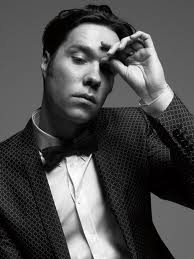 The American rocker Rufus Wainwright stepped out before an expectant audience at Davies Symphony Hall for the world premiere of his new song cycle based on five sonnets by William Shakespeare dressed in a puffy, white Renaissance shirt embellished with what looked like a piece of squashed Victoria sponge cake, lilac taffeta trousers and patent black clogs. A silver chain-link necklace glistened between the dark hairs on his pale chest.
The American rocker Rufus Wainwright stepped out before an expectant audience at Davies Symphony Hall for the world premiere of his new song cycle based on five sonnets by William Shakespeare dressed in a puffy, white Renaissance shirt embellished with what looked like a piece of squashed Victoria sponge cake, lilac taffeta trousers and patent black clogs. A silver chain-link necklace glistened between the dark hairs on his pale chest.Fortunately, Wainwright composes better than he dresses.
Five Shakespeare Sonnets includes a part for solo tenor voice featuring jagged atonal hops, swooping highs and lows and emotional melodic lines. The orchestration has some beautiful colors in it. A grave viola solo and sparkling glockenspiel scales are just two of the details I picked out of the texture. And the San Francisco Symphony does a wonderful job of balancing turbulence and stillness.
The only other thing, besides the soloist's getup, which bothered me about last night's performance, was Wainwright's voice. Wainwright's nasal twang always has a hint of desperation about it. At Davies Symphony Hall, it sounded overbearing and whiney amplified as it was with the swirling orchestra behind it.
As I listened, I couldn't help but imagine how amazing the piece would sound sung by a classically-trained or jazz singer. I hope the work gets future airings with different kinds of voices. On its maiden voyage, I don't think the the composer does justice to his own composition by singing it himself.
On a related note, it's curious to me that the San Francisco Symphony would go to the trouble of commissioning such a famous artist to create a new work and then fail to engage the organization's main figurehead, Michael Tilson Thomas, to lead the world premiere. Concertmaster, Alexander Barantschik was also missing. Last night, a young Englishman, Michael Francis, made his San Francisco Symphony debut on the podium and associate concertmaster Nadya Tichman sat in the first chair. The absence of the two uppermost artistic personnel of the organization suggests a lack of interest or faith in its commissioning strategy and process.
 Soprano Measha Brueggergosman performed her recital debut in San Francisco last night under the auspices of San Francisco Performances at the Herbst Theatre.
Soprano Measha Brueggergosman performed her recital debut in San Francisco last night under the auspices of San Francisco Performances at the Herbst Theatre.The audience was on the small side: Though the singer is a big name in her native Canada, she's not so well known in the Bay Area right now. But I suspect that every person who heard her last night went home clamoring to hear her lustrous voice again.
Brueggergosman's voice takes a little adjusting to. It doesn't have a uniform, bell-like quality. It has many many colors, from voluptuous, velvety tones to glittering, on-the-edge-of-breathy edges. She's also a performer who sings with her entire body. She bends her legs, moves her trunk and emotes with every ounce of her being.
There was something about the quality of last night's recital with pianist Justus Zeyen, which featured songs by Mozart, Schubert, Duparc, Turina, Chopin, Strauss and Berg, that had the air of a jazz rather than a classical performance. It's partly to do with the way that Brueggergosman sings -- that breathy edge to her voice is very jazz -- and partly to do with the way she stands (very close to the piano, with her hand resting on it) and sways. This gave the classical works she performed a slightly different tint which made us listen in a new way.
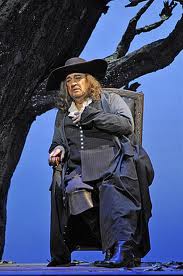 Speaking of brilliant stage performers who aren't spring chickens anymore and yet hardly ready to screw the lids on their pots of greasepaint -- as I recently did on this blog of Chita Rivera -- Placido Domingo, who will shortly turn 70, shows very few signs of letting up.
Speaking of brilliant stage performers who aren't spring chickens anymore and yet hardly ready to screw the lids on their pots of greasepaint -- as I recently did on this blog of Chita Rivera -- Placido Domingo, who will shortly turn 70, shows very few signs of letting up.As the title character in Franco Alfano's Cyrano de Bergerac, which is currently being produced at the San Francisco Opera, the great Spanish singer holds the audience in thrall. His voice is full fills the sizable War Memorial auditorium effortlessly. He is as comfortable bellowing war cries at the bottom of his register as he is hitting the high notes while singing about romance. Even under the weight of his floppy, feathered hat and prosthetic nose, Domingo manages to exude a virile presence. At 69, he is equally capable of embodying youth in the throes of ecstasy, as he is a sick, old man lamenting lost love at the end of the story.
Domingo doesn't move around a great deal on stage. During the sword fights, other people move around him but he stays fairly still. This conceit works quite well from the point of you of conveying a sense of the character's effortless power over his enemies. But it also gives the game away slightly: Domingo has a great deal of energy. But he's perhaps not going to dart around the stage with a sword as much today as he might have done in years past.
If only the opera itself were more worthy of its star. There's a reason why Alfano's Cyrano isn't performed very often: Musically, it's fairly inert, with few remarkable instrumental passages and no memorable arias. It takes a performer of the caliber and reputation of Domingo to bring it to the stage and keep us glued to our seats.
On another completely unrelated note: The School of the Arts in San Francisco, a fabulous and terribly under-funded public school which produces many fine young performers, is planning to undertake a tour with its choral ensemble to Chicago in 2011. The choir will be participating in master classes with renowned choral conductors and professional singers as well as presenting several free public concert collaborations with celebrated Chicago choirs. To raise the $75,000 necessary to send the students to the mid-west, SOTA is undertaking a big fundraising campaign. The school is selling CDs and greetings cards online. To find out how to donate to a worthy cause, please click here. "It's a fantastic educational opportunity to build our repertoire and grow as artists," says the head of SOTA's choral program, Todd Wedge, about the upcoming tour. "Please help us realize our dreams."
 Journalists love interviewing people who don't toe the party line, but give an opposing view on a subject. A detractor's opinions provide that all-important bit of tension in a story that makes it more fully rounded and readable. This opposing viewpoint is particularly important (but hard to come by) in arts journalism, where most interviewees -- not to mention the reporters themselves -- tend to spend their time talking about how great an artist's work is and how excited they are about it. This is why so much arts journalism is bland and expendable.
Journalists love interviewing people who don't toe the party line, but give an opposing view on a subject. A detractor's opinions provide that all-important bit of tension in a story that makes it more fully rounded and readable. This opposing viewpoint is particularly important (but hard to come by) in arts journalism, where most interviewees -- not to mention the reporters themselves -- tend to spend their time talking about how great an artist's work is and how excited they are about it. This is why so much arts journalism is bland and expendable.But what happens when you're lucky enough to stumble on a person willing to state an unorthodox viewpoint on a subject but that person ends up making points that seem worthless, petty and ultimately unusable? Disappointment prevails.
This is the feeling I got yesterday while collecting insights on the work of a famous artist whom I am writing about this week for the New York Times. In preparation for the story, I talked to a number of people yesterday on the phone ranging from one of the artist's project managers to curators at local museums who have worked with the artist on commissions in recent years.
With the exception of the detractor in question, everyone I have spoken with so far provided at least a few interesting insights.
Sadly, the one commentator who has an opposing view on the artist's output said very little that is usable. A reputed expert in the particular field of art in which the subject of my article operates, the interviewee launched into a negative tirade about the artist's work, but was completely unable to substantiate her feelings from an aesthetic standpoint. All I could glean from talking to her was that she objects to the artist on account of his fame and ability to command large fees for major commissions. She thinks that the money and commissions should be spread around and not automatically given to this particular artist.
Duh! Frankly, I would expect an expert of her caliber to provide me with insights that go beyond the blindingly obvious. That a few famous artists swallow up the lion's share of the limelight and the corresponding accolades and monetary gains isn't remotely interesting grounds upon which to base a critique of their work.
Oh well. On this occasion, I'll be hard-pressed to use this detractor's comments in my story.
 The newly-reopened Venetian Room at the Fairmont Hotel was completely packed for Friday evening's one-night-only performance by Broadway icon Chita Rivera. Bay Area Cabaret, the organization under whose umbrella the concert was taking place, was forced to turn people away.
The newly-reopened Venetian Room at the Fairmont Hotel was completely packed for Friday evening's one-night-only performance by Broadway icon Chita Rivera. Bay Area Cabaret, the organization under whose umbrella the concert was taking place, was forced to turn people away.And understandably so: The triple-threat stage diva displayed heart-palpitating emotional range in a show whose musical offerings ranged from songs from Westside Story to Bye Bye Birdie to the Kiss of the Spider Woman. Rivera moved like someone a fraction of her age. And her voice, if not quite as melodious as it once was, delivered the messages of the songs with a throaty and rich lyricism that made them even more meaningful than they might have otherwise been.
If I have even a fraction of the energy and joie de vivre that this consummate performer possesses at the age of 77 when I'm approaching her years, I'll count myself exceedingly lucky.
 It's always exciting when a new cultural space opens up in a city, especially in tough economic times.
It's always exciting when a new cultural space opens up in a city, especially in tough economic times.Holly's, a new comedy club located in the same building that houses the multiplex movie theatre at 1000 Van Ness Avenue, launched last night with a lineup of comedians that included the San Francisco stalwart Michael Capozzola (who served as MC for the evening), a British ex-pat by the name of George Corrigan and headliner David Crowe (pictured) who hails from Seattle.
The space itself, which is a good, intimate size for comedy but lacks any individualizing details and feels a little bland with its non-descript cafeteria-style formica-topped rectangular tables and chairs, needs to be full of people to make it glow. The atmosphere in the room last night was lively and warm by the time the show started.
What I tasted of the menu, which offers shrimp cocktails, turkey and beef sliders, grilled cheese sandwiches, tomato soup, fish & chips and other simple comfort foods, was delicious, despite the to-be-expected sluggish and erratic opening-night service standards. (I'm sure Holly's will have no trouble ironing out this kink in time.)
I enjoyed parts of the show itself immensely: David Crowe is a comedian of quirky intelligence: His first appearance on stage came before Corrigan's warm-up act as a "visiting" comedian and last-minute addition to the program named Lloyd Althauser. Lloyd, an efete and nerdy coin collector from the South, turned out to be an alter ego of David Crowe and a very funny one at that. The comedian's characterization of the coin collector remains a highlight of the evening for me. I also loved the freewheeling nature of his humor during the main set. The comedian found refreshing ways to approach very familiar subjects such as pregnancy and online dating.
I was much less impressed with Corrigan, whose comedy revolved almost entirely around tired jokes about being a British person in America and the Anglo-American divide in general. And Capozzola, a comedian who is usually intelligent and daring, wasn't very much of either last night. Perhaps he doesn't enjoy playing the MC for these types of occasions.
If I have any criticism of Holly's programming, it's that there is not a single female comedian on the lineup between now and the end of the year. I hope that the club will rectify this issue in 2011.
P.S. Holly's has a heartwarming story behind it which I'd like to relay by way of postscript: Holly Horn, the namesake of the club and a former salesperson at the luxury car dealership across the street from the new venue on Van Ness Avenue, had a long-time dream of opening a nightspot for comedians. Her boss, a 91-year-old luxury car salesman by the name of Kjell Qvale, was so impressed with Holly, whom he met in 1997 when she came to work for his company, that he decided to open a club with her. Qvale, who was holding court at a ringside table last night and even got up to do a sweet little standup routine himself, became the owner of Holly's and Holly, the club's proprietor. The rest, as they say, is history. Let's hope that the club has a long a distinguished future.
My bah-humbug aversion came to the fore yesterday when I was forced to battle the lunchtime baseball crowds at Civic Center on my way to teach a class in Berkeley. The train system (BART) was a mess. I ended up grabbing light rail (MUNI) to the Embarcadero and then hopping on BART across the water from there. Only too happy to escape to the sanity of the East Bay.
I am excited that the SF Giants won the world series. It was great to see so much euphoria in the city, especially since the elections had produced such lackluster results.
Yet the marauding, drunken crowds with their drunken shouts of "Go Giants!" and "Fock Yeah!" rang dull to my ears. The celebration spilled into trouble at various points with stories of people being beaten up and store windows smashed.
I don't mean to be a killjoy, but all those people dressed in orange -- the smell if not the full-on color of danger -- make me feel nervous. There must be better ways to show civic pride than this.
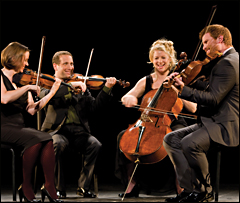 Is it a good thing or a bad thing that normal concert etiquette goes out of the window for lunchtime and commuter hour concerts?
Is it a good thing or a bad thing that normal concert etiquette goes out of the window for lunchtime and commuter hour concerts?I kind of think it's a shame that the format allows people to wander in and out at will and read a book or take care of some work while having the live music on as "background" to their activities.
On the other hand, there's something very special about being able to come in off the street for an hour and forget the crazy world outside while immersing yourself in gorgeous live music in a casual setting.
Though some people around me were only half paying attention to the music (they appeared to be working) I spent a wonderful 45 minutes or so in the company of the Cypress String Quartet yesterday as the group played at Old St Mary's Cathedral in downtown San Francisco as part of the church's "Noontime Concert" series.
But I broke etiquette rules in that I was very late in getting to the venue.
The roomy church was pretty full of people. The part of the program which I managed to catch, Stravinsky's spiky Concertino and Elena Ruehr's playful and kinetic String Quartet No. 3 (2001), a new discovery for me, lifted my heart. The Cypress Quartet played elegantly and with a pristine sense of ensemble. The articulation in the Ruehr was especially delicate and precise. The players seemed very serious though. Their mood seemed not to go with the laid-back atmosphere in the church.
As I slipped my suggested donation of $5 into a box on my way out, I made myself promise to seek out more of these lunchtime events. I'm sure they're happening all over the city. I just don't get away from my desk enough in the middle of the day.
And as for the debate about whether people should treat such events with the same reverence as they do evening concerts or eat their sandwiches throughout, I think there's a case to be made on both fronts. By their very nature, these concerts are meant to be less formal. But there are limits. Audiences should at least have respect for the performers. Cell phone conversations should be banned. And in cases where tickets are not sold, everyone in the room should feel obliged to leave a donation.
 It's been hard to avoid baseball in San Francisco lately. Last night in particular was a symphony of blaring car horns and shrieking, gimme-five-slapping pedestrians as citizens made their excitement about the home team's victory over the Texas Rangers strongly felt.
It's been hard to avoid baseball in San Francisco lately. Last night in particular was a symphony of blaring car horns and shrieking, gimme-five-slapping pedestrians as citizens made their excitement about the home team's victory over the Texas Rangers strongly felt.One of the things that's kept me in a state of semi-attention in recent weeks has been the mid-game singing of "God Bless America." Some of the performances have been tuneful (such as the wife of a soldier who sang the song last night in Dallas with soulful tones). Others have had the opposite effect (the actress Martha Plimpton's rendition lacked basic intonation accuracy a few days ago.)
But good or bad, all the versions I have heard this year have one detail in common: An obsession with being melismatic.
The florid embellishments of R&B divas have a lot of show-off appeal and they help to spin out lines and make them sound fuller and more wave-like. But they sound horrible when they're not done properly. And even if such ornamentation is handled skillfully, it's kind of boring to hear this approach used constantly in all of the games.
There is more than one way to approach a patriotic song. Sounding like Whitney Houston isn't a prerequisite for putting "God Bless America" across in a sports stadium. Next world series, should I choose to pay attention, I'd like to hear singers give the song a different spin. They might consider taking out all the curlicues and simply sing it straight like a shaker hymn or shape note tune. This might not help the teams to hit more home runes, but it'll certainly make the song stand out.
 There are few better ways to spend Halloween, culturally-speaking, than exploring ruins. But to get the most out of the experience, you ideally need to visit ruins that aren't really designated as such. Because to feel a proper chill down your spine, it's better to be alone than surrounded by hundreds of other thrill-seekers.
There are few better ways to spend Halloween, culturally-speaking, than exploring ruins. But to get the most out of the experience, you ideally need to visit ruins that aren't really designated as such. Because to feel a proper chill down your spine, it's better to be alone than surrounded by hundreds of other thrill-seekers. A wander around the ghostly remains of Ponderosa Ranch above Incline Village near Lake Tahoe, Nevada, yesterday afternoon proved to be the perfect Halloween experience, particularly because it's a forbidden one: The place, which was once a bustling tourist attraction, has been bereft of activity since it closed down in 2004.
Between 1967 and 2004, Ponderosa Ranch was a theme park based on the 1960s television western Bonanza. It was the home of the affluent Cartwright family in the series. Portions of the last five seasons of the TV series and three TV movies were filmed at the location.
Today, the shuttered theme park isn't the sort of place that welcomes snoopers. Forbidding chain-link fences and signs at the entrance just off the freeway keep curious passersby out. But if you hike a trail around the back of the site up the mountainside, you can sneak in another way easily enough.
In the late October sunlight, Ponderosa Ranch was completely still and ever so slightly spooky. The skeletal forms of rusty old farm equipment resembled the remains of dinosaurs. Stacked picnic tables and benches appeared to be coffins in the lengthening afternoon shadows. Exploring the dusty barns and unswept trailers revealed a wealth of dormant treasures such as old wooden signs advertising horse rides and $2 cowboy breakfasts, defunct movie cameras and lights, heavy wooden wagon wheels and creaking ferris wheel horses and camels, their once-brightly painted coats peeling off.
I kept thinking that we'd come across a corpse amidst all that debris and quietude. Thankfully we didn't. All in all, the clandestine visit still made for the ultimate off-the-beaten-track Halloween scare.
